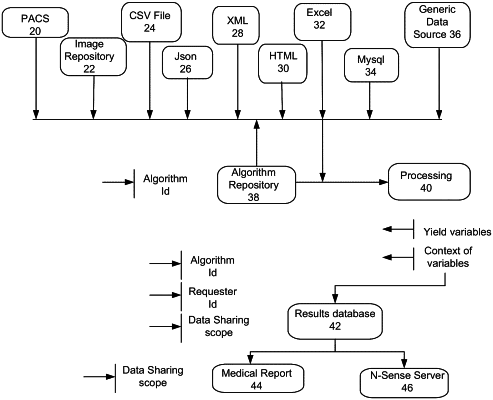| CPC G16H 15/00 (2018.01) [G06F 16/248 (2019.01); G16H 30/20 (2018.01); G16H 30/40 (2018.01); G16H 50/20 (2018.01); G16H 50/30 (2018.01); G16H 70/20 (2018.01); H04L 67/01 (2022.05)] | 6 Claims |

|
1. A system having patient image processing capability and being in compliance with health insurance portability and accountability act (HIPAA), the system comprising:
a database; and
a process application server communicatively connected to a picture archiving and communication system (PACS) server that stores medical data of patients in Digital Imaging and Communications in Medicine (DICOM) format, wherein the process application server is operated to:
create a DICOM-complying structured query based on directives by a user for retrieving a specific set of patient medical images from the PACS server;
transmit the DICOM-complying structured query to the PACS server, wherein, in response to the structured query;
receive, from the PACS server, a list of matched service-object pairs (SOPs) that include the specific set of patient medical images;
transmit, to the PACS server, a request to transfer the specific set of patient medical images;
in response to the request to transfer, receive encrypted files of the specific set of patient medical images from the PACS server in a bulk manner and in compliance with confidentiality regulations of the HIPAA;
decrypt the encrypted files of the specific set of patient medical images;
anonymize the decrypted files of the specific set of patient medical images by removing personal information of the patients from the decrypted files;
register the anonymized files of the specific set of patient medical images in the database;
reformat the specific set of patient medical images in the registered files from the DICOM format into NIfTI or Analyze format;
operate a quantifying algorithm on the specific set of patient medical images in the NIfTI or Analyze format to generate numerical values representing areas, volumes, thicknesses, curvatures, depths, or roughness of features in the specific set of patient medical images;
analyze the numerical values representing the areas, volumes, thicknesses, curvatures, depths, or roughness of the features in the specific set of patient medical images to detect a pattern of abnormality in the specific set of patient medical images;
extract, from the numerical values, a set of numbers corresponding to the pattern of abnormality; and
generate a report of the pattern of abnormality in the specific set of patient medical images using the extracted set of numbers.
|